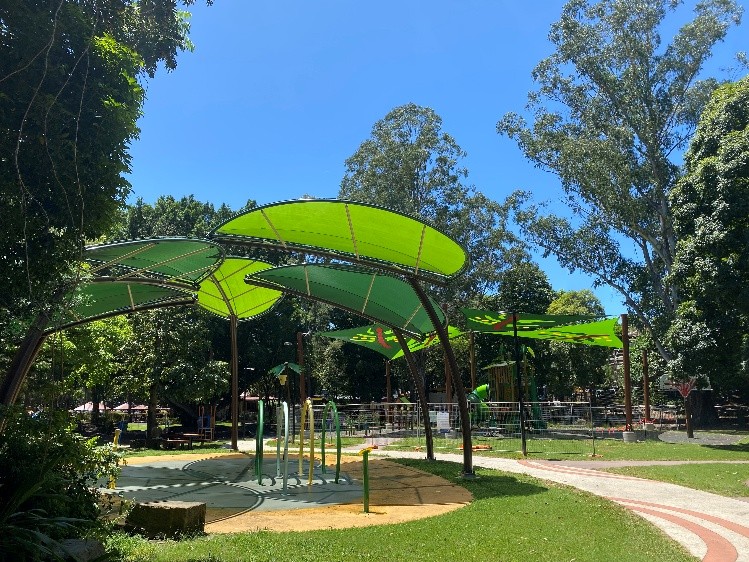When many people think of a canopy or shade structure, the immediate utility that comes to mind is protection from sun or rain. But in modern architectural and landscape design, canopies can — and should — offer much more. A properly designed structure can become a catalyst for enhanced ambiance, sustainable performance, and multifunctional usage that elevates outdoor spaces. In this article, we explore how canopy and shade structures can be integrated with lighting, energy systems, acoustic treatments, branding, rainfall capture, and more — and we’ll show real examples from Versatile Structures to illustrate the possibilities.
1. Lighting & Ambience: Making Shade Structures Work After Dark
One powerful way to extend the usefulness of a canopy is to integrate lighting solutions. Whether for hospitality (restaurants, bars), educational settings, or public spaces, lighting transforms a daytime shade into an evening destination.
- Uplighting & downlighting: Concealed LED strips along beams or tension members can cast gentle ambient light upward or downward, accenting structural forms and creating a soft glow.
- Feature pendants or fixtures: Where aesthetics matter, suspended light fixtures within a canopy can become focal elements.
- Smart controls: Motion sensors, brightness dimming, and programmable schedules can reduce energy use and adapt the mood over time.
Example: The Munich Brauhaus project features six outdoor umbrellas incorporating lighting, heaters, vinyl branding and decoration. This is a perfect case where shade becomes part of the dining atmosphere long after sunset. Versatile Structures
By planning lighting together with structural design (e.g. wiring conduits within posts, removable fixtures for maintenance), you avoid retrofitting headaches.
2. Solar & Energy Integration: Shade as Power Generation
In high-sun environments, combining photovoltaics with shade is a natural marriage. Canopies with solar panels not only provide shelter, they generate clean electricity — turning a structure into an asset rather than a cost.
- BIPV (Building Integrated Photovoltaics): Panels are incorporated into the canopy roof itself, rather than just mounted atop it.
- Hybrid designs: Shade fabrics or membranes can be paired with discrete solar panels in less visually sensitive zones.
- Battery storage & local use: Captured energy can be stored or fed into nearby loads (lighting, pumps, EV charging, etc.).
Although Versatile Structures’ project list does not explicitly list a solar canopy, the Woolworths Logan Reserve car park shade structure is a prime candidate for retrofit with solar panels. Versatile Structures In future projects, combining parking shade with solar PV is a strong value proposition (shading cars while producing energy).
3. Rainwater Capture & Active Drainage Systems
Why not make your canopy work double duty — shading above, harvesting water below? Especially in Australia, rainfall is a resource worth capturing.
- Gutter integration: Floating or sloped canopy surfaces can channel run-off into gutters or scuppers.
- Hidden downpipes: Posts can encase vertical downpipes, delivering water to storage tanks or infiltration systems.
- Filter & settling systems: Before storage, filters and first-flush systems help ensure water quality.
Example: The Pool Membrane project is a waterproof cover for a pool, effectively capturing rain while also protecting the pool’s surface. Versatile Structures This shows the structural potential of combining waterproofness and runoff control. A carefully detailed canopy could likewise harvest rain for reuse in irrigation, washdown, or greywater systems.
4. Acoustic & Microclimate Control
Large outdoor structures can sometimes exacerbate noise issues (e.g. reflections, echoes) or amplify wind-driven sounds. Thoughtful design can turn them into acoustic aids instead.
- Acoustic absorptive panels: Behind membranes or beneath canopies, fabrics or perforated panels can dampen sound.
- Curved surfaces & diffusers: Using structural curves strategically can redirect or diffuse sound waves.
- Wind breaks and secondary membranes: In windy areas, adding fabric side walls or louvers can reduce draft, channel airflow, or block prevailing winds.
While Versatile Structures’ project list doesn’t explicitly call out acoustic installations, many of the school entranceway and early learning centre shade structures (e.g. the Rosebery School Entranceway) could benefit from acoustically sensitive design, especially in noisy urban settings. Versatile Structures
5. Branding, Identity & Signage Integration
For commercial, institutional, or retail clients, canopies serve as prominent visual anchors. Integrating signage, branding graphics, and design motifs can turn structures into part of the marketing footprint.
- Fabric prints or embossings: Logos or graphics can be printed or laser-cut into membranes.
- Cutouts or perforations: Strategic perforations can spell shapes or icons when backlit.
- Attachment frames: Lightweight frames or rails allow signage panels to be swapped or updated.
- Color and material palette: Choosing distinct fabric or frame colours strengthens brand recognition.
Example: The Newmarket Advertising Structure / GOA Curved Billboard projects are directly in the advertising/signage realm. For instance, the curved digital billboard installed by Versatile shows how structural steel, curvature, lighting, and surface design come together for maximum visual impact. Versatile Structures+1 Another example is Village Green Entrance, where entrance signage is custom-designed, manufactured, and integrated into the structure. Versatile Structures
6. Retrofitting & Phased Upgrades
One of the more compelling strategies is to design your canopy with future upgrades in mind. The initial project need not include every feature — but planning for integration later avoids costly rework.
- Pre-installed conduits and sleeves: Leave empty ducts or sleeves in structural members for future wiring, plumbing, or cabling.
- Modular attachment zones: Design zones where lighting, signage, screens, or solar can be bolted on later.
- Scalable loads: Oversize some structural members to handle extra weight down the line.
- Deferred modular panels: Use placeholders or dummy panels that allow insertion of upgraded modules later (e.g. solar modules, acoustic panels).
For example, a school or commercial shade structure could initially be built for sun protection and later, when budgets permit, receive lighting, weatherproofing, or branding attachments.
7. Case Study Synthesis: A Few Standouts
Here are a few curated examples from Versatile Structures’ portfolio to illustrate how multi-functional integration is already being practiced, or could be extended:
- Dreamworld / Tiger Island: In their theme park shade installations, there is both structural drama and visual identity embedded in the fabric shapes and silhouettes. Versatile Structures
- Munich Brauhaus: As mentioned, umbrellas with integrated lighting, heaters, and dropdown panels show how dining zones can be enhanced. Versatile Structures
- Woolworths Logan Reserve Car Park: A large structural footprint providing shade for many vehicles — ripe for retrofit with PV or rain capture systems. Versatile Structures
- Village Green Entrance: Signage integrated into structural design gives identity and form in one package. Versatile Structures
- Pool Membrane Waterproof Cover: Demonstrates how waterproofing, form, and functional performance can combine, hinting at how more active utility can be built in. Versatile Structures
By drawing from real projects, you can help prospective clients visualise how a canopy is more than just a roof — it’s an opportunity for enhancement.
Practical Tips for Planning a Multi-Functional Canopy
- Involve specialists early — lighting, structural engineers, sustainability consultants should be in the loop early, not retrofitted later.
- Design for maintenance — ensure access pathways, removable panels, and serviceability for cabling or pipe runs.
- Balance weight vs function — features like solar, signage, or acoustic panels add weight; structural design must account for them.
- Manage waterproofing and drainage — when combining features, ensure membranes, gutters, and penetrations are carefully detailed.
- Plan for stage-based implementation — if budgets or permits limit full scope, partition into stages (shade first, then energy/lighting, then branding).
- Use modular systems and standard components — this reduces cost and simplifies upgrades or replacements.
Conclusion
In today’s architectural and landscape environment, a canopy is no longer just a static shade or rain cover. It’s a canvas, a performance surface, and an infrastructure platform. By integrating lighting, energy capture, water harvesting, acoustics, branding, and phased expansion, your shade structure can become a transformational element — not just a functional one.
For clients, this means greater value and longer lifespan; for designers and constructors like Versatile Structures, it opens the door to more creative, high-value work. When prospective clients browse your project gallery, they’ll see that your structures do more than shelter — they elevate spaces.
If you like, I can format this into your blog style (with subhead styles, image callouts, SEO keywords, alt texts, etc.) and propose specific inline links to each project. Would you like me to prepare that polished version for you?

